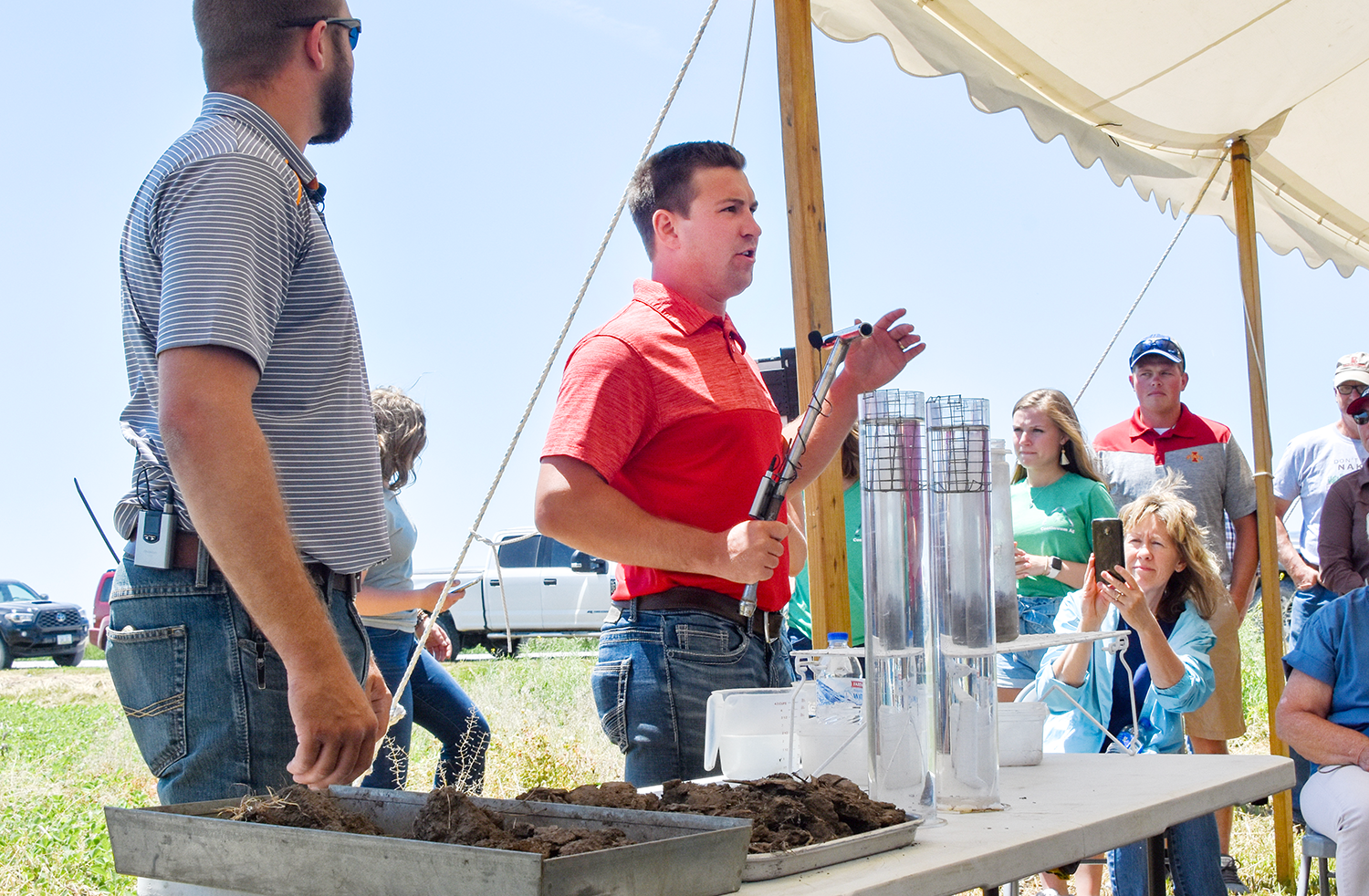
By Kurt Lawton
Taking a more holistic view of farming — from the health of microbes in the soil to the health of crop profits — has farmers paying attention to a young soil health consultant in eastern Iowa.
Mitchell Hora’s data-driven approach to soil biology, combined with his passion for on-farm research and education through field days, helps expand soil health and water quality in Iowa and beyond. With his unique skill set, Hora recently joined the Business Council of the Iowa Agriculture Water Alliance (IAWA). The Business Council works with IAWA to drive the adoption of conservation practices and other innovations that will improve water quality. Mitchell also serves on the Conservation Infrastructure initiative’s Strategy Working Group.
Founding Continuum Ag during college in 2015, Mitchell honed his initial business and soil health philosophy thanks to support from excellent mentors during internships. He attributes his work drive and passion for conservation from his best mentor, his dad Brian. In the first minute of talking to Mitchell, you realize his belief that traditional ag is not sustainable. He seeks more significant peaks to climb and to share.
Mitchell likens his surname Hora, which is Czech for mountain/peak, to his business philosophy. “In ag, we have to continually improve and continually climb the mountain as if there is no peak,” he says. “I chose Continuum because, while it implies a sequence of elements that are perceivably the same, a deeper evaluation shows that individual elements are quite distinct.”
While some want to treat every farm, field, and corn plant as all the same, Hora says, “At a molecular and microscopic component level, each microbe and corn plant is unique. My company helps deliver the data so farmers can manage at that specific level.”
Mitchell transformed his soil health consulting company into a soil health data company with an online analytics platform. “We provide farmers with a new type of soil sampling and testing program called RightWay. It’s a comprehensive 10-acre-zone soil sampling program using the Haney test.”
He crafts his version of an N, P, & K variable-rate fertility recommendation based on all test results, organic carbon, biological activity and plant-available nutrients data. “From this data in our TopSoil System, we can also connect farmers with options like field imagery from various sensors, cover crops expertise, carbon markets, and other types of consultants.”
Guidance on soil health and profits
Continuum Ag currently has 10 employees, with a successful business footprint that extends into 40 states and 11 countries. “Our main focus is to get many tools into a cohesive system that helps farmers make short-term decisions to optimize the farm and improve soil health,” Mitchell says. In the long-term, the company provides a roadway to profitability and sustainability, with options to participate in carbon markets or other programs that compensate farmers for ecosystem services.
Local on-farm research — 60-inch corn spacing, specialty crops, interseeding multi-species cover crops, relay cropping, biological product testing, and thousands of soil tests to quantify changes — occurs annually on this 150-year-old, seventh-generation farm near Ainsworth. Mitchell and Brian believe in sharing what they learn during field days and through social media.
At a recent field day, the Horas emphasized honesty and profits alongside their cropping and cover crop trials. “In year one of cover crops, you do have more expense and risk, and yes, we lost money in that first small-acreage trial,” Mitchell says. “But we’ve also seen a 0.25% gain in organic matter in one year. With the cover crop mix we’re using in our 60-inch corn trials, our goal is to feed the 2022 corn crop to reduce synthetic fertilizer and drive more profit.”
The Horas can’t imagine ever farming without cover crops. After only three years of cover crops in one part of Mitchell’s 40-acre field, the soil infiltration rate test showed the first inch of simulated rainfall was absorbed in 24 seconds, and the second inch took 2.5 minutes. Last year that same field recorded 2 minutes for the first inch and 14 minutes for the second. “In our relay crop field, it absorbed four inches of rain in less than five minutes, which is amazing,” he adds.
Valued partnerships
Mitchell is working with the Iowa Soybean Association on a relay cropping project, growing small grains and soybeans together. Preliminary data from 2019 trials showed a profit range from $95 to $212 per acre with relay crops compared to 30-inch conventional soybeans.
The Hora’s harvested the cereal rye grain heads sticking above the soybean canopy on July 10th, using their existing combine and bean head. They save the grain to seed as a cover crop in the fall or spring.
Mitchell has a passion for gathering as much wisdom as he can soak up from soil health farmer-pioneers. He especially pays homage to long-time conservation-minded and innovative Washington County farmers like Steve Berger. They have grown their farm business over decades using cover crops and building soil health.
Ramping up to meet the goals of the Iowa Nutrient Reduction Strategy
Mitchell hopes more farmers will gain from early cover crop farmers’ experience to leapfrog over and avoid common beginning mistakes and build soil health and water quality even faster. He also advises farmers to work together closely with landowners to share cover crop costs and build the soil for mutual benefit, both short and long term.
“By implementing sustainable practices that stabilize soil aggregates, our fields can hold excess rainfall to avoid flooding, erosion, and nutrient loss that occur from too much water coming too fast in tile lines, creeks, and rivers,” he concludes.
